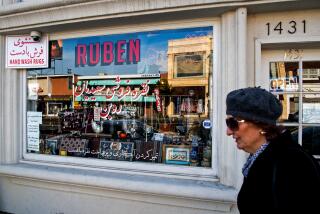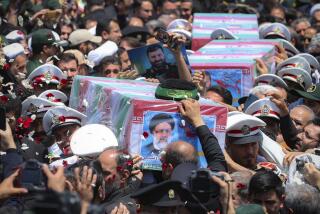The Greatest Political Executioner of the Decade : IN THE NAME OF GOD The Khomeini Decade <i> by Robin Wright (Simon & Schuster: $19.95; 284 pp.; 0-671-67235-5) </i>
- Share via
In the contemporary world, the first draft of popular history is composed by journalists. When a distinguished journalist who has covered a landmark story for 10 years writes a book about the event, the result can add depth, scope and perspective to her original dispatches. Robin Wright is such a journalist, and her account of the Iranian revolution surpasses the expectation.
The title of the book, “In the Name of God,” signifies the centrality of religion ( Shii Islam ) in revolutionary Iran, and the subtitle, “The Khomeini Decade,” recalls the Ayatollah’s dominant role in defining the concrete dictates of the faith from the birth of the Islamic Republic on Feb. 11, 1979, to the day of his death on June 3, 1989.
A chronology as well as an interpretive portrayal of events during this tumultuous period, this book is intended for general readers but does not avoid or impose labels or complex phenomena. Wright aims at explaining the degree to which the Iranian revolution has succeeded or failed in pursuit of its self-proclaimed goals.
Wright, a reporter for the Los Angeles Times, begins her lucid narrative by placing Iran’s grievances against the Shah’s regime in historical perspective, and by doing so makes the Islamic revolution intelligible. Pointing out that the sudden fall of the Iranian state was a surprise not only to foreign specialists but also to native revolutionaries themselves, Wright shows that Alexis de Tocqueville’s remark on the French Revolution--”Never was any such event so inevitable, yet so completely unforeseen”--is equally applicable to the Iranian cases. Thus when the Shah was forced into exile, his successors did not have a practical plan for the new Iran.
What united the diverse elements of the spontaneous mass movement was more negative than affirmative. For a variety of sociohistoric reasons, the vast majority of Iranians had come to believe that the destruction of the monarchy would necessarily improve their lives. The kind or the degree of this supposed gain was not a matter of serious concern.
Consequently, in the early days of the victory, disagreements among the revolutionaries were so basic that calls for compromise invariably fell on deaf ears. Disputed issues included the name of the republic, the structure of authority, the role of the state in the national economy, the origin of political legitimacy, the nature of foreign policy, women’s rights and the extent of autonomy for the national minorities: In the midst of a multifaceted clash of ideas over such questions, Khomeini remained the uncontestable source of appeal and arbitration. In the beginning, he seemed to be above factionalism, but as time went on, his close ties with the fundamentalist clerics became evident.
The militant fundamentalists were determined to transform Iran into an Islamic state, but they had no clear idea of what the institutions and laws of such a state would be like. Even Khomeini, whose writings were more specific about political matters than were those of any of his colleagues, merely assigned to the government the traditional duties of protecting Islam, defending the frontiers, administering justice and collecting taxes.
As Wright correctly observes, for months after the fall of the shah, “it was not at all clear that Khomeini intended for the Islamic Republic to become a theocracy, or a state ruled by the clergy.” Indeed, evidence supports Wright’s view that at first “Khomeini seemed content to leave the workings of government in the hands of the Tehran technocrats, while his role was at first limited to guide or counselor during disputes.”
The rise of Khomeini as the ruler of a theocratic Iran was as unimaginable to him as it was to the Iranian people. In fact, few even saw him as a threat to the progressive aspirations of the revolution. Precipitating the birth of the Iranian theocracy were: 1. the capacity of fundamentalist teachers (mullahs) to galvanize the urban poor and control the network of mosque-centered committees throughout the country, 2. the pathetic fragmentation of the secular forces and 3. the lure of absolute power to Khomeini. Of these three factors, Wright thoroughly analyzes the first, makes some perceptive comments on the second and virtually ignores the third.
The seizure of the American embassy in Tehran on Nov. 4, 1979, was the first pivotal moment in the post-revolutionary power struggle because it produced an irreversible advantage for the militant fundamentalists, drew Khomeini to the center of decision-making in the daily affairs of the state, checkmated the radical-left groups and put the liberal forces on the defensive.
The demonstrations in front of the American embassy compound that immediately followed the shah’s admission to the United States on Oct. 22, 1979, were organized by the radical-left competitors of the clerics. This development deeply worried Khomeini and his lieutenants because it was the first occasion since the fall of the shah that leftists had taken the initiative in a major public mobilization.
Prime Minister Mehdi Bazargan and the liberal forces he represented were opposed to such confrontation with Washington, but given the general public’s perception of the shah’s admission to the United States as a hostile act toward the revolution, they could not mobilize much support for their position.
The militant fundamentalists responded to this volatile situation by stealing the issue of anti-Americanism from the radical left. They sent a group of their supporters to occupy the embassy to take the U.S. diplomatic personnel hostage. This was one of the shrewdest moves Khomeini made in his political career.
Wright has done an excellent job of explaining the dramatic impact of the episode on Iran’s domestic politics. She shows how Khomeini used the ensuing hostage crisis to consolidate his power and disarm or discredit his opponents. The dividends he gained from the situation convinced him that America was more useful to him as an enemy than as a friend.
Wright also demonstrates how the Iran-Iraq war played into the hands of the militant fundamentalists and paved the way for the expansionist phase of the Islamic revolution. For the Iraqi invasion of Iran on Sept. 22, 1980 provided Khomeini with an opportunity to attempt to export the revolution in the name of defending Islam and Iran. In June, 1982, when Iran gained the upper hand in the war, Khomeini rejected any suggestion of settling the conflict through negotiation.
The Ayatollah and his lieutenants were so mesmerized by their successes that they actually came to think that there was no limit to what their religious zeal could achieve. The clerics’ intoxication finally was ended when the Iraqis managed to reverse the military balance and made it imperative for Khomeini to accept U.N. Security Council Resolution 598, which called for a cease-fire and peaceful resolution to the conflict.
The guns fell silent at the end because both sides were exhausted, morally and economically, and because the Reagan Administration, in a reversal of its policy during the first seven years of the war, saw more benefit in ending the feud than in fueling it. A million deaths, 2 million wounded, hundreds of billions of dollars in material destruction and the immense suffering of the people could not move the 88-year-old spiritual leader of the Islamic Republic, but an actual threat to his regime was altogether a different matter.
Wright’s assessments of the Islamic Republic’s performance are as valid as they are painful. It seems that the achievements of the “government of God” are limited to its own survival and the sharing of political power “beyond the wealthy, Westernized elite.” The cost of this accomplishment, it must be noted, has been massive repression and the spread of terror among dissidents. In the decade of Khomeini there have been nearly 15,000 confirmed political executions in Iran--far more than the combined number of such killings in the rest of the world combined.
As for the Ayatollah’s ambition to spread his message abroad, evidence shows that “Tehran’s brand of Shi’ite extremism never took hold except in neighborhoods of chaotic Lebanon and among handfuls of Gulf Arabs.” Even in Lebanon, the so-called pro-Iranian Hezbollah have been reduced to the mercenary types. Khomeini’s fanatic followers in Lebanon came to a rude awakening with the revelation of the Ayatollah’s secret contacts with Washington and Tel Aviv.
In the economic sphere, the ruling clerics brought chaos and misery to Iranian society. Even the urban poor, their supposed constituency, were “more impoverished during the revolution’s first decade than under the shah, with little to show for the ‘dignity’ that Khomeini had promised.” And in the realm of dictating “moral” conduct, the Islamic regime’s record is equally as dismal. While people were whipped in public for drinking alcohol, underground bootlegging became a multimillion-dollar trade in the theocracy. Similarly, even after nearly 2,000 drug-related executions and incarceration of 50,000 addicts in labor camps, official statistics put the number of addicts at 1 million.
Before the revolution, opium dominated drug use in Iran. Today heroin has displaced opium--a vengeful victory for modernization in the Islamic Republic. As Wright concludes, when Khomeini died on June 3, 1989, his legacy included an uncertain future, a deeply polarized society, an increased dependency on the outside world for the nation’s basic necessities, a cruel machinery of repression, Iraqi occupying forces on Iranian soil, a pariah status for Iran in the international community, a devastated economy and a pervasive feeling of disillusionment or betrayal for millions of Iranians who thought the revolution would produce some civility in their political life.
Given Wright’s realistic portrayal of what the decade of Khomeini did to Iran, it is puzzling that she chooses the religious honorific imam for Khomeini and presents him as a man of holy qualities. He did use such words as faith, vision and dream to characterize his motives and sensibilities. And after all, he was not the only national leader to have dragged God into war and politics; nor was he the first to leave the fighting to Him when the shortages of weapons, money and men became critical.
But we cannot forget the fact that it was his ignorant and inchoate view of the world that prolonged an internecine war for six years and directed Iran’s revolutionary energy toward the delusion of grandeur. In the words of Mahmud Dowlatabadi, Iran’s foremost novelist: under Khomeini’s guidance, “The word ‘war’ became sanctified. The revolution, we were told, would flower in war.”
Indeed, it was not religious faith but psychopathology of power that shaped Khomeini’s choices and turned him into a despot. He personally approved mass executions of political prisoners and never made an attempt to reason with his critics. He was a credible moral opponent of the shah, but once in power he became a shrewd connoisseur of intrigue and an extremist practitioner of the “ends justifying the means” game.
He might have begun his career with wholesome intentions, but after 10 years ruling Iran, he demonstrated to us all that the exercise of absolute power can infect the prayer mat with more plague than it did the peacock throne.
More to Read
Sign up for our Book Club newsletter
Get the latest news, events and more from the Los Angeles Times Book Club, and help us get L.A. reading and talking.
You may occasionally receive promotional content from the Los Angeles Times.










